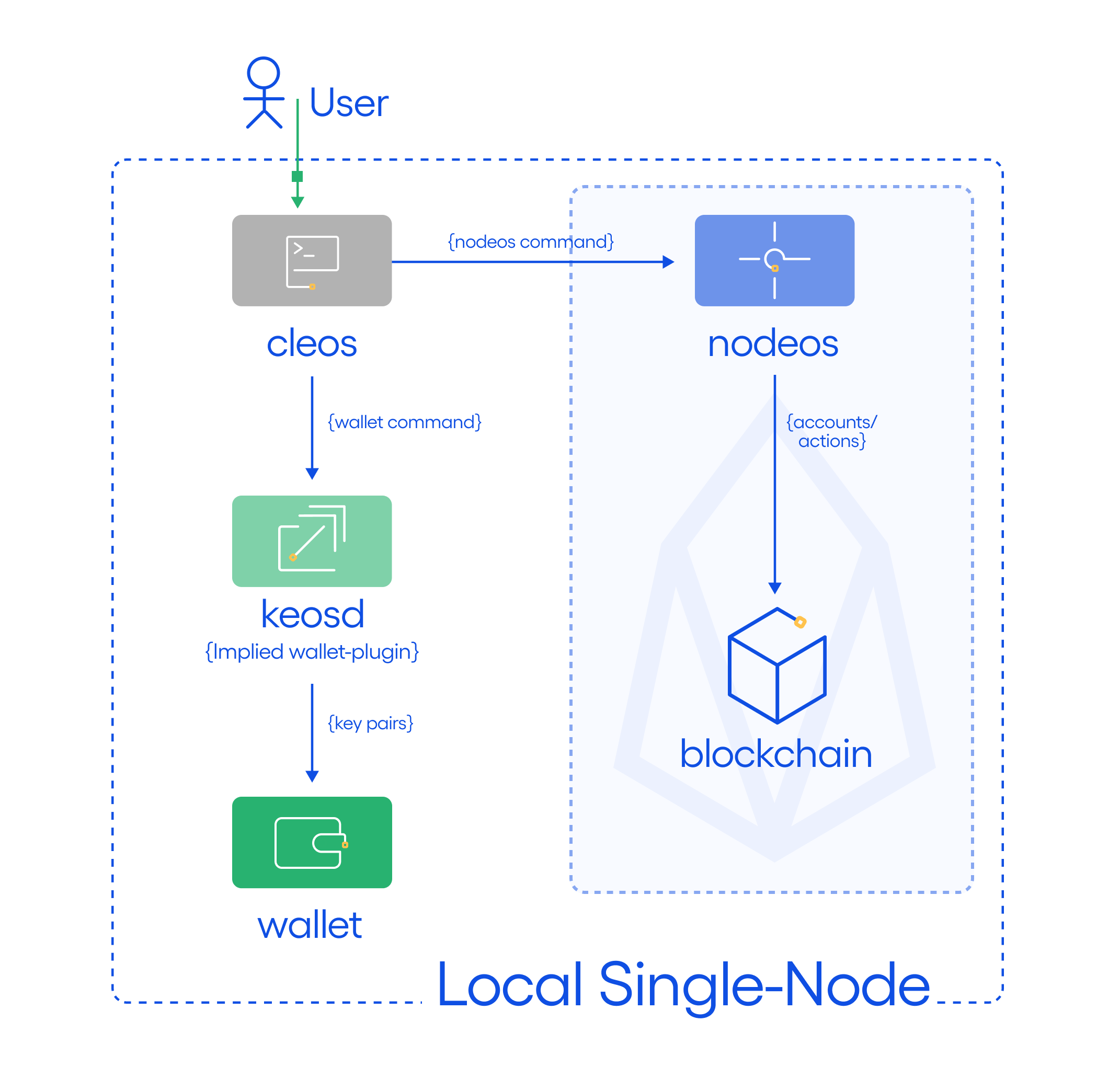Goal
This section describes how to set up a single-node blockchain configuration running on a single host with consensus protocol enabled. This is referred to as a single host, single-node testnet with consensus. We will set up one node on your local computer and have it produce blocks. The following diagram depicts the desired single host testnet.

cleos is used to interact with wallets, and send actions to the blockchain. keosd performs wallet management, including digital signing. If not started explicitly, keosd is started by cleos by default.
Before you begin
- Install the EOSIO software before starting this section.
- It is assumed that
nodeos,cleos, andkeosdare accessible through the path - Know how to pass Nodeos options to enable or disable functionality.
Steps
Open one "terminal" window and perform the following steps:
- Add the development key to the wallet
- Start the Producer Node
- Preactivate Protocol Features
- Get the System Smart Contracts
- Install eosio.boot System Contract
- Activate the Remaining Protocol Features
- Install eosio.bios System Contract
1. Add the development key to the wallet
Execute the following at the command prompt:
cleos wallet import --private-key 5KQwrPbwdL6PhXujxW37FSSQZ1JiwsST4cqQzDeyXtP79zkvFD32. Start the Producer Node
Start your own single-node blockchain with this single command:
nodeos -e -p eosio --plugin eosio::producer_plugin --plugin eosio::producer_api_plugin --plugin eosio::chain_api_plugin --access-control-allow-origin='*' --contracts-console --http-validate-host=false --verbose-http-errorsAfter running nodeos, you should get log messages similar to the ones below. It means the blocks are successfully produced.
info 2021-01-07T15:59:07.902 thread-0 producer_plugin.cpp:2053 produce_block ] Produced block 98fa5cdd7ce06ae8... #162 @ 2021-01-07T15:59:08.000 signed by eosio [trxs: 0, lib: 161, confirmed: 0]
info 2021-01-07T15:59:08.401 thread-0 producer_plugin.cpp:2053 produce_block ] Produced block 972190051a840992... #163 @ 2021-01-07T15:59:08.500 signed by eosio [trxs: 0, lib: 162, confirmed: 0]
info 2021-01-07T15:59:08.901 thread-0 producer_plugin.cpp:2053 produce_block ] Produced block d8727439a26f36f6... #164 @ 2021-01-07T15:59:09.000 signed by eosio [trxs: 0, lib: 163, confirmed: 0]
info 2021-01-07T15:59:09.401 thread-0 producer_plugin.cpp:2053 produce_block ] Produced block 6f2302aeb944c5ca... #165 @ 2021-01-07T15:59:09.500 signed by eosio [trxs: 0, lib: 164, confirmed: 0]
...
info 2021-01-07T15:59:10.902 thread-0 producer_plugin.cpp:2053 produce_block ] Produced block 8cd2384a28818e19... #168 @ 2021-01-07T15:59:11.000 signed by eosio [trxs: 0, lib: 167, confirmed: 0]
...
info 2021-01-07T15:59:11.900 thread-0 producer_plugin.cpp:2053 produce_block ] Produced block c8c82b50249e9f6d... #170 @ 2021-01-07T15:59:12.000 signed by eosio [trxs: 0, lib: 169, confirmed: 0]
...At this point, nodeos is running with a single producer, eosio.
3. Preactivate Protocol Features
All of the protocol upgrade features introduced in v1.8 and on subsequent versions require a special protocol feature, also known as PREACTIVATE_FEATURE, to be activated.
To activate the special protocol PREACTIVATE_FEATURE run the following command from a terminal:
curl --request POST \
--url http://127.0.0.1:8888/v1/producer/schedule_protocol_feature_activations \
-d '{"protocol_features_to_activate": ["0ec7e080177b2c02b278d5088611686b49d739925a92d9bfcacd7fc6b74053bd"]}'4. Get the System Smart Contracts
All of the protocol upgrade features introduced in v1.8 and on subsequent versions also require an updated version of the system smart contract which can make use of those protocol features.
Two updated reference system smart contracts, eosio.boot and eosio.bios, are available in both source and binary form within the eos repository. You can build them from source or deploy the binaries directly.
4.1 Use the Prebuilt System Smart Contracts
To use the prebuilt system smart contract execute the following commands from a terminal:
cd ~
git clone https://github.com/EOSIO/eos.git
cd ./eos/contracts/contracts/
pwdNote the path printed at the command prompt, we will refer to it later as EOSIO_SYSTEM_CONTRACTS_DIRECTORY.
Alternatively you can build the system smart contracts from source with the following commands:
cd ~
git clone https://github.com/EOSIO/eos.git
cd ./eos/contracts/contracts/
mkdir build
cd build
cmake ..
make
pwd5. Install eosio.boot System Contract
To install the eosio.boot system contract execute the following command from a terminal. Make sure you replace the EOSIO_SYSTEM_CONTRACTS_DIRECTORY with the directory path where the eosio.boot.wasm and eosio.boot.abi files are located.
cleos set contract eosio EOSIO_SYSTEM_CONTRACTS_DIRECTORY/eosio.boot/bin/ eosio.boot.wasm eosio.boot.abiYou should see something similar to the following output:
Reading WAST/WASM from /users/documents/eos/contracts/contracts/eosio.boot/build/eosio.boot.wasm...
Using already assembled WASM...
Publishing contract...
executed transaction: 2150ed87e4564cd3fe98ccdea841dc9ff67351f9315b6384084e8572a35887cc 39968 bytes 4395 us
# eosio <= eosio::setcode {"account":"eosio","vmtype":0,"vmversion":0,"code":"0061736d0100000001be023060027f7e0060067f7e7e7f7f...
# eosio <= eosio::setabi {"account":"eosio","abi":{"types":[],"structs":[{"name":"buyrambytes","base":"","fields":[{"name":"p...6. Activate the Remaining Protocol Features
After you deploy the eosio.boot contract, run the following commands from a terminal to enable the rest of the features which are highly recommended to enable an EOSIO-based blockchain.
echo KV_DATABASE
cleos push action eosio activate '["825ee6288fb1373eab1b5187ec2f04f6eacb39cb3a97f356a07c91622dd61d16"]' -p eosio
echo ACTION_RETURN_VALUE
cleos push action eosio activate '["c3a6138c5061cf291310887c0b5c71fcaffeab90d5deb50d3b9e687cead45071"]' -p eosio
echo CONFIGURABLE_WASM_LIMITS
cleos push action eosio activate '["bf61537fd21c61a60e542a5d66c3f6a78da0589336868307f94a82bccea84e88"]' -p eosio
echo BLOCKCHAIN_PARAMETERS
cleos push action eosio activate '["5443fcf88330c586bc0e5f3dee10e7f63c76c00249c87fe4fbf7f38c082006b4"]' -p eosio
echo GET_SENDER
cleos push action eosio activate '["f0af56d2c5a48d60a4a5b5c903edfb7db3a736a94ed589d0b797df33ff9d3e1d"]' -p eosio
echo FORWARD_SETCODE
cleos push action eosio activate '["2652f5f96006294109b3dd0bbde63693f55324af452b799ee137a81a905eed25"]' -p eosio
echo ONLY_BILL_FIRST_AUTHORIZER
cleos push action eosio activate '["8ba52fe7a3956c5cd3a656a3174b931d3bb2abb45578befc59f283ecd816a405"]' -p eosio
echo RESTRICT_ACTION_TO_SELF
cleos push action eosio activate '["ad9e3d8f650687709fd68f4b90b41f7d825a365b02c23a636cef88ac2ac00c43"]' -p eosio
echo DISALLOW_EMPTY_PRODUCER_SCHEDULE
cleos push action eosio activate '["68dcaa34c0517d19666e6b33add67351d8c5f69e999ca1e37931bc410a297428"]' -p eosio
echo FIX_LINKAUTH_RESTRICTION
cleos push action eosio activate '["e0fb64b1085cc5538970158d05a009c24e276fb94e1a0bf6a528b48fbc4ff526"]' -p eosio
echo REPLACE_DEFERRED
cleos push action eosio activate '["ef43112c6543b88db2283a2e077278c315ae2c84719a8b25f25cc88565fbea99"]' -p eosio
echo NO_DUPLICATE_DEFERRED_ID
cleos push action eosio activate '["4a90c00d55454dc5b059055ca213579c6ea856967712a56017487886a4d4cc0f"]' -p eosio
echo ONLY_LINK_TO_EXISTING_PERMISSION
cleos push action eosio activate '["1a99a59d87e06e09ec5b028a9cbb7749b4a5ad8819004365d02dc4379a8b7241"]' -p eosio
echo RAM_RESTRICTIONS
cleos push action eosio activate '["4e7bf348da00a945489b2a681749eb56f5de00b900014e137ddae39f48f69d67"]' -p eosio
echo WEBAUTHN_KEY
cleos push action eosio activate '["4fca8bd82bbd181e714e283f83e1b45d95ca5af40fb89ad3977b653c448f78c2"]' -p eosio
echo WTMSIG_BLOCK_SIGNATURES
cleos push action eosio activate '["299dcb6af692324b899b39f16d5a530a33062804e41f09dc97e9f156b4476707"]' -p eosio7. Install eosio.bios System Contract
To deploy the eosio.bios system contract execute the following command from a terminal. Make sure you replace the EOSIO_SYSTEM_CONTRACTS_DIRECTORY with the directory path where the eosio.bios.wasm and eosio.bios.abi files are located.
cleos set contract eosio EOSIO_SYSTEM_CONTRACTS_DIRECTORY/eosio.bios/bin/ eosio.bios.wasm eosio.bios.abiIf you want instead of eosio.bios, a more elaborate system smart contract like eosio.system, you have to build it first and then execute the following command from a terminal (or from the shell). Make sure you replace the EOSIO_SYSTEM_CONTRACTS_DIRECTORY with the directory path where you have built the eosio.system system contract, the directory path where eoios.system.abi and eosio.system.wasm are located.
cleos set contract eosio EOSIO_SYSTEM_CONTRACTS_DIRECTORY/eosio.system/ eosio.system.wasm eosio.system.abi